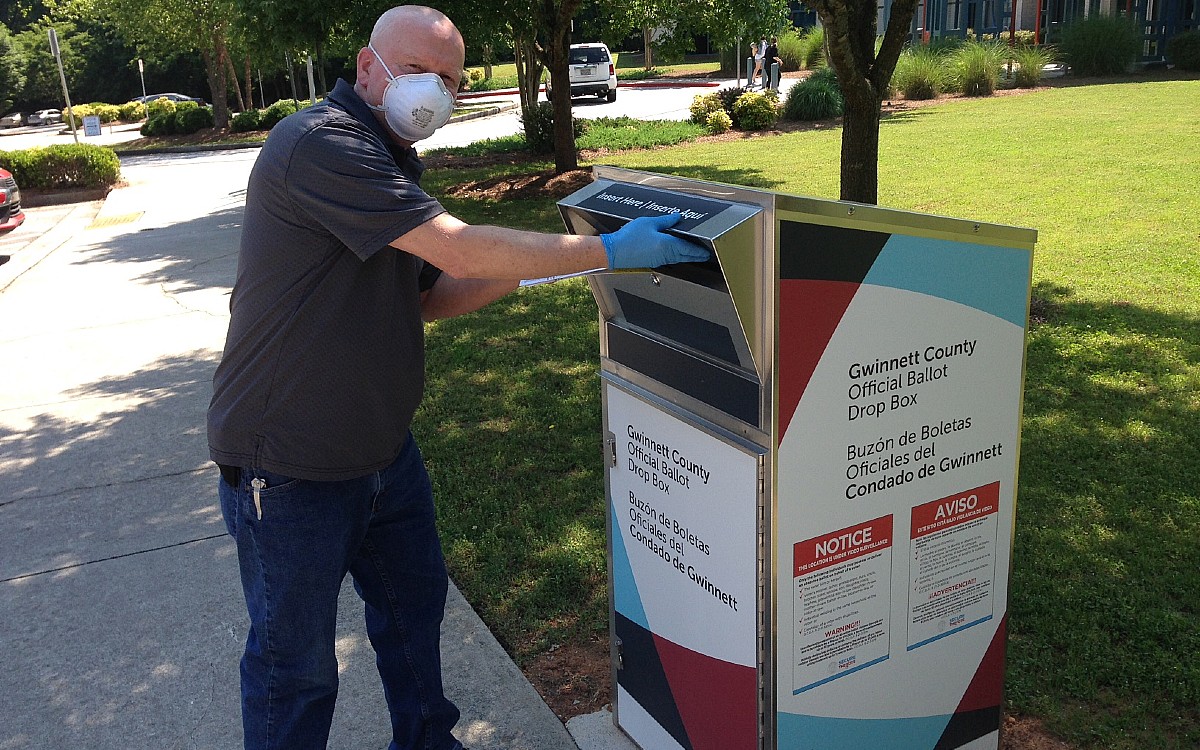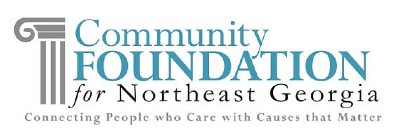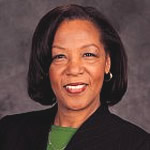GwinnettForum | Number 20.39 June 5, 2020
CHILLY COMPLEX. This is the IceCube Lab, located at the South Pole, and is the computing center for the IceCube Observatory. Some of the equipment is buried between 1.5 and 2.5 km under the ice at the South Pole. Read about this in a Mercer University professor’s research article in Today’s Focus below.
 TODAY’S FOCUS: Mercer Professor in Study of Cosmic Rays from South Pole Lab
TODAY’S FOCUS: Mercer Professor in Study of Cosmic Rays from South Pole Lab
EEB PERSPECTIVE: Missing Baseballs from Riots and Two Public Officials Taking Action
SECOND VIEW: Here’s GwinnettForum’s List of Endorsed Primary Candidates
SPOTLIGHT: Renasant Bank
FEEDBACK: Enjoy Hearing from Four Readers Addressing Varied Subjects
UPCOMING: GGC President Issues Letter of Recent Events and Leadership
NOTABLE: Community Foundation of NE Georgia Exceeds Million Dollar Goal
RECOMMENDED: I’m Ready to Talk, Compiled by Robert Babcock
GEORGIA TIDBIT: Elijah Clarke One of the Few Revolutionary War Heroes of Georgia
MYSTERY PHOTO: Apparently Quiet and Peaceful Setting Is Today’s Mystery Photo
Mercer professor studies cosmic rays from South Pole lab

An artist’s rendition of a cosmic ray colliding with the Earth’s atmosphere, resulting in an air shower.
(Editor’s Note: College professors often conduct research. Frank McNally of Mercer University in Macon recently told Gwinnett County Rotarians of his research working with the IceCube Lab at the South Pole. It’s buried between 1.5 and 2.5 km under the ice at the South Pole. Enjoy stretching your brain in a new arena. –eeb)
Dr. Frank McNally
Assistant Professor of Physics, Mercer University
MACON, Ga. | Astronomy is a science where, for the most part, you can look but not touch. We know from our daily lives that looking with different wavelengths of light changes the picture you see. X-rays at the doctor’s office and infrared night vision come to mind. This same approach can be applied to astronomy.
We can study the earliest light from the Big Bang in microwaves, see violent bursts of gamma rays, and even directly image a black hole using radio! Modern astronomy expands on this idea. In addition to studying light, we now use different signals, or “messengers,” to map the universe.
In my work with the IceCube Observatory, I study a class of messengers called cosmic rays, which includes charged particles like protons, electrons, and atomic nuclei. Cosmic rays are the most energetic particles in the universe. They have up to 10 million times greater in energy than anything we can produce on Earth. But we still don’t know where they come from.
Identifying the sources of these extreme particles is one of the leading, unsolved questions in astronomy, and could let us test the fundamentals of physics in new and exciting ways.
How is it possible that we don’t know where these particles come from? First, space is host to a myriad of magnetic fields. As a charged particle travels toward us from a distant source, those magnetic fields bend and change its path. How much a particle deviates from its original path depends on its energy and charge.

A simulated cosmic ray shower as seen by IceTop. In the left plots, color indicates the time at which the tank was hit, from earliest (red) to latest (purple), and the size of each circle represents how much light hit the tank.
By the time a cosmic ray arrives at Earth, its direction may not point back to its origin! In order to use cosmic rays to point back to a source, you either need to (a) understand the magnetic fields it passed through, or (b) look at particles so energetic that they don’t bend much at all.
This idea brings us to the second complicating issue, which is that high-energy cosmic rays are exceptionally rare. At the highest energies, we expect roughly one cosmic ray per square kilometer per century. In order to improve our chances of seeing these rare events, we let them smash into Earth’s atmosphere, creating a shower of particles that we detect at ground level.
The IceCube Observatory detects cosmic rays in this way: not by catching them directly, but by detecting the many particles produced by a collision with the atmosphere. The ice at the South Pole is incredibly transparent; light sensors placed deep underground can see light emitted as these air-shower particles reach the surface and travel underground. Signals observed by the detector are then transmitted via cables to a computing station at the surface, before satellites pass them along to IceCube affiliates all over the world.
Currently I am working with undergraduate researchers at Mercer University on improving cosmic ray reconstruction. Given what we see at ground level, how can we determine the energy, direction, and composition of the cosmic ray that produced a cosmic shower? By applying modern machine learning algorithms like image recognition, we hope to improve on previous techniques.
An accurate reconstruction of cosmic ray energy and composition will let us study interstellar magnetic fields in new ways, hopefully leading to the discovery of a nearby source!
See Figure 2: An artist’s rendition of a cosmic ray colliding with the Earth’s atmosphere, resulting in an air shower.
Look at Figure 3: A simulated cosmic ray shower as seen by IceTop. In the left plots, color indicates the time at which the tank was hit, from earliest (red) to latest (purple), and the size of each circle represents how much light hit the tank.
To prepare the data for an image recognition algorithm, we need to transform the observed data into a pixelated grid then separate the information into the amount of light detected and arrival time layers.
- Have a comment? Send to: elliott@brack.net
Missing baseballs from riots; 2 public officials taking action
By Elliott Brack
Editor and Publisher, GwinnettForum
JUNE 5, 2020 | It’s eerie what really hits you and gets your attention during big news events, like the recent riots across the country. (One map I saw initially showed riots in all but six states: Idaho, Wyoming, South Dakota, Vermont, New Hampshire and…..Mississippi!)
 Like millions of quiet Americans all over the country, we were upset, saddened and mad last week about the way peaceful marches and protests turned into riots, rebellion, lawlessness and anarchy.
Like millions of quiet Americans all over the country, we were upset, saddened and mad last week about the way peaceful marches and protests turned into riots, rebellion, lawlessness and anarchy.
It was an ugly and scary element of our country, as frustration abounded out of protest into unrest and agitation.
As one quiet American said, what was really unreal is that many agitators were destroying their everyday neighborhoods, as well as friendly businesses.
 Later on, I saw this photograph of a smashed display at the All Star Grill at 200 Peachtree Street in Atlanta. The photo, taken by David Luce, was of a wall display of baseballs, signed by former players, which were not especially valuable. They might be replaced. Yet the vandalizing of this wall of balls essentially showed the meanness and craziness of those participating in the lawlessness.
Later on, I saw this photograph of a smashed display at the All Star Grill at 200 Peachtree Street in Atlanta. The photo, taken by David Luce, was of a wall display of baseballs, signed by former players, which were not especially valuable. They might be replaced. Yet the vandalizing of this wall of balls essentially showed the meanness and craziness of those participating in the lawlessness.
The week’s events also gave us a glimpse of another side of leadership, involving two Gwinnett officials that made us proud. When Sheriff Butch Conway heard of a protest beginning, he took action. He went to the event, talked with people there, felt their frustration, and then walked alongside them during the peaceful protest. No doubt, he helped quell the demonstration.
County Commissioner Marlene Fosque also similarly visited with those protesting, and later marched with them in the peaceful protest. “I thought of myself as a go-between, willing to risk myself. As community leaders, we must go to where the people are.”
Sheriff Conway added: “As long as you can talk and reason with people, you are not going to have as many problems. It’s when people don’t listen where problems start.”
Yes, we must wonder what might have happened had these two officials not gone and met with those protesting. Perhaps their very presence held back potential violence, and steered the gathering to a quieter ending. We offer to these two our thanks for stepping forward.
That same week we were reminded of a photograph etched in our mind from Atlanta’s Civil Rights Days. When in 1966 a riot erupted in the Summerhill neighborhood of Atlanta, the late Mayor Ivan Allen realized that something had to be done. He went to the scene of the angry gathering, climbed on top of a police vehicle, and with a bullhorn addressed the crowd with a plea for calm. It worked. Like Marlene Foske and Butch Conway, he took action that help modify the situation. We need more leaders like these, who even in the face of danger, put their life at risk for the common good.
For we can understand and sympathize with those protesting the recent death of a black man in Minneapolis, Minn. We can understand the frustration that many people have, black and white, over such a development. After all, we have seen on video something that is just not right, not by man’s laws, but by God’s laws. We want action. We want reform. We want justice. But justice can be terribly slow.
It has been an ugly week in our country. We must do better. We must change our thinking. And we must not forget, but continue to find paths to improve our nation.
Those missing and looted baseballs illustrated an ugly story. We must do better.
- Have a comment? Send to: elliott@brack.net
List of GwinnettForum’s endorsed primary candidates

Dropping off his ballot at the Lucky Shoals Park ballot collection box is Curtis Spears of Norcross.
By Elliott Brack
Editor and Publisher, GwinnettForum
JUNE 5, 2020 | With the three primaries (Democratic, Republican and Non-Partisan) coming on Tuesday, June 9, today GwinnettForum will reiterate the endorsements we made recently of candidates.
This repeat may be less important than in previous years, since so many people have either personally early-voted, or voted by absentee ballots. However, for those voters who wait until the last part of the season to vote, we give these endorsements again.
To make it easier for you, we will give candidates we earlier endorsed by political party, as voters in the primary only see one set of candidates, that is, those of the party of their choice. (Candidates who are unopposed are not listed.)
Democratic Primary candidates:
- For U.S. Senate (To succeed David Perdue): Teresa Pike Tomlinson
- For Congress, 4th District: William Haston
- For Congress, 7th District: Carolyn Bourdeaux
- For Congress,10th District: No endorsement
- For Public Service Commission, 4th District: John Noel
- For Chairman, Gwinnett County Commission: Lee Thompson Jr.
- For Gwinnett County Commission, District 3: John Henry Moye Jr.
- For Gwinnett County School Board, Post 1: No endorsement.
- For Gwinnett County School Board, Post 5: Louise Radloff
- For District Attorney of Gwinnett: Wesley “Wes” Person
- For Sheriff of Gwinnett County: Curtis Clemons
- For Tax Commissioner of Gwinnett County: Maureen McIvor
- State Senate District 9: Nikki Merritt
- State Senate District 41: Beverly R. Jones
- State Senate District 45: Matielyn Jones
- State Senate District 48: Michelle Au
- State House District 93: Dar’Shun Kendrick
- State House District 99: Melvin Lim
- State House District 104: Nakita Hemingway
- State House District 106: Rebecca Mitchell
Republican Primary candidates:
- For Congress, 7th District: Renee S. Unterman
- For Chairman, Gwinnett County Commission: Marcia L. Neaton
- For County Commission, District 1: Laurie McClain
- For County Commission, District 3: Matt DeReimer
- For Sheriff of Gwinnett County: Louis “Lou” Solis
- For Senate District 45: Sammy Baker
- For House District 103: Donald Schmidt
For Non-Partisan judgeships:
- For Justice of the Supreme Court (Bethel seat): Charles Bethel
- For Justice of the Supreme Court (Warren seat): Hal Moroz
- For State Court Judge (Bratton seat): Shawn Bratton
- For Superior Court Judge (Rich seat): Randy Rich
- For Superior Court Judge: (Schrader seat) Kathryn “Kathy” Schrader
Those are our selections. Now, if you haven’t, your job is to get out and vote!
- Click here to read candidates’ answers to six questions by GwinnettForum.
- Have a comment? Send to: elliott@brack.net
Renasant Bank
 The public spiritedness of our sponsors allows us to bring GwinnettForum.com to you at no cost to readers. Today’s sponsor is Renasant Bank, which has humble roots, starting in 1904 as a $100,000 bank in a Lee County, Miss. bakery. Since then, we have grown to become one of the Southeast’s strongest financial institutions with approximately $12.9 billion in assets, approximately 2,500 associates, and more than 190 banking, lending, wealth management and financial services offices in Mississippi, Alabama, Tennessee, Georgia and Florida. All of Renasant’s success stems from each of our banker’s commitment to investing in their communities as a way of better understanding the people we serve. At Renasant Bank, we understand you because we work and live alongside you every day.
The public spiritedness of our sponsors allows us to bring GwinnettForum.com to you at no cost to readers. Today’s sponsor is Renasant Bank, which has humble roots, starting in 1904 as a $100,000 bank in a Lee County, Miss. bakery. Since then, we have grown to become one of the Southeast’s strongest financial institutions with approximately $12.9 billion in assets, approximately 2,500 associates, and more than 190 banking, lending, wealth management and financial services offices in Mississippi, Alabama, Tennessee, Georgia and Florida. All of Renasant’s success stems from each of our banker’s commitment to investing in their communities as a way of better understanding the people we serve. At Renasant Bank, we understand you because we work and live alongside you every day.
- For more details, go to www.renasantbank.com
- For a list of other sponsors of this forum,
Feels uncredentialed diagnosis of Biden was not credible
Editor, the Forum:
![]() Michael Wood’s letter to the editor demonstrates how “fake news” gets shared. Certainly Mr. Woods does not have the credentials to diagnose Mr. Biden with the serious medical condition of dementia. Biden has disclosed that he has a stuttering problem. That is a far cry from dementia. Mr. Woods needs to be much more careful in making such accusations.
Michael Wood’s letter to the editor demonstrates how “fake news” gets shared. Certainly Mr. Woods does not have the credentials to diagnose Mr. Biden with the serious medical condition of dementia. Biden has disclosed that he has a stuttering problem. That is a far cry from dementia. Mr. Woods needs to be much more careful in making such accusations.
— Alan Schneiberg, Sugar Hill
Here’s what really made her day recently
Editor, the Forum:
Michelle for vice president? It would make my DECADE if Biden takes Michelle into this.
— Kelly Land, Suwanee
Says recent comment about racists was insulting, dismissive
Editor, the Forum:
Your recent comment entitled “Dear Racists” by Andy Brack is insulting and dismissive on so many levels.
The narrative is hyperbolic and banal. And the comparison to hate in Nazi Germany is incongruent with what we are seeing in America. In World War II, 85 million people died with estimates of 30 million being from crimes against humanity.
Injustice is not only racial, although demographics like race and gender are certainly easier to identify. You can see the contrast between white and black, male and female. Injustice is a complicated subject that is sadly part of our human experience. When you try to make it a bumper sticker, the depth and breadth is lost. Injustice is cultural and societal. Last year, in Rwanda almost a million people were slaughtered. Do you call the murderers racists? Or are they something else?
I am nothing like the lady in Central Park nor the police officer in Minneapolis. I don’t agree with everything President Trump does or any president before him, but I don’t always disagree either.
— Mary Hester, Duluth
Enjoyed recent edition; Looks forward to comments
Editor, the Forum:
The issue of June 2 gets to the core of major concerns confronting our country.
I can’t wait to see the comments from that issue.
To Andy: Great story. Thanks for speaking out.
To Gregg: Does this mean as long as “he scratches my back,” he could be the devil incarnate?
— Alvin Johnson, Sandy Springs
Send us your thoughts: We encourage you to send us your letters and thoughts on issues raised in GwinnettForum. Please limit comments to 300 words. We reserve the right to edit for clarity and length . Send feedback and letters to: elliott@brack.net.
GGC president issues letter of recent events and leadership
(Editor’s Note: Georgia Gwinnett College President Dr. Jann L. Joseph this week issued a letter concerning the current situation and campus leadership. Here is that letter. –eeb)
Dear GGC Community:
I am both troubled and saddened by the events that have been taking place in our country. I don’t bear this burden alone and know that I am not alone in my feelings of anxiety and despair. I suspect that many, if not all of you, feel something similar as well.
What we’re witnessing is not only outrage over George Floyd, Breonna Taylor, Ahmaud Arbery, and a list of other lives that were senselessly lost; but we’re also watching public outrage at a consistent and long history of racial injustices, marginalization, and socio-economic inequalities that have plagued our country for far too long.
In a time where it feels like not much makes sense, we do know that the fires will extinguish, the riots will stop, the outrage will subside, the news cameras will move on, the stores will reopen, and eventually the pandemic will end. Nonetheless, we recognize that systemic pain, poverty, injustice, and inequality will remain unless we engage in constructive activities to transform our future.
The purpose of this letter is not to patronize our community or attempt to minimize the strong emotions that you are feeling. There is not a message that will come from the administration that will undo the range of emotions that many if not all of us have felt, whether those feelings are felt personally or because someone we know has experienced what it feels like to be treated differently, simply because you are viewed as different.
However, we are all different, and at GGC, we strive to celebrate everyone AND their differences. The one thing that everyone reading this message has in common is that we are a part of GGC; thus, my hope is that everyone reading this message will be committed to fostering an inclusive and equitable environment at GGC because we are Grizzly Strong.
As we look to build and move forward, the campus as a whole has to be involved in a renewed commitment to our inclusive environment. That includes EVERYONE. We cannot necessarily control what happens in the world, but we can and will control what happens on our campus, in our classrooms, and in the interactions that take place between students, faculty, and staff. Racism and bigotry have no place on our campus. We should see humans on the inside by looking beyond the color of their skin.
To everyone who may feel targeted, or undervalued, or hated, based on nothing more than the color of your skin, your disability, your national origin, or anything else that makes you “different,” remember that your GGC family values you and appreciates you for who you are.
Evidenced by the names of campus leadership at the bottom of this letter, every department on this campus is in support of you as we strive to continue fostering an inclusive and equitable environment at GGC. For those who would like information regarding mental health resources, please click on the links below for more information.
- https://www.beam.community/bvtn
- https://www.thestevefund.org
- https://www.nami.org/Support-Education/Diverse-Communities/African-American-Mental-Health
Thank you for being you, thank you for your differences, and thank you for being a part of GGC.
Sincerely, Dr. Jann Joseph
Campus Leadership in Support of this Letter
Dr. T.J. Arant, Senior Vice President for Academic and Student Affairs/Provost
Mr. Frank Hardymon, Vice President for Business and Finance
Mr. Michael Poll, Vice President for Enrollment Management Services
Dr. Christine Miller Divine, Vice President for Information Technology
Dr. Michelle Rosemond, Vice President for Student Engagement and Success
Mr. Terry Schneider, Associate Vice President for Operations, and Chief of Police
Ms. Katherine Kyle, Associate Vice President of Human Resources
Ms. Sloan Jones, Associate Vice President of Communications
Ms. Jennifer Hendrickson, Associate Vice President of Advancement
Ms. Luann Causland, Executive Assistant to the President
Ms. Rebekah Myers, General Counsel and Chief Legal Affairs Officer
Mr. Jarmon DeSadier, Executive Director of Office of Diversity & Equity Compliance
Ms. Hayley Howell, Director of Government Relations
Mr. Russ Mathis, Auditor
Dr. Darin Wilson, Associate Vice President for Athletics and Athletics Director
Dr. Laurel Holland, Interim Dean, School of Liberal Arts
Dr. Justin Jernigan, Dean, School of Transitional Studies
Mr. Tomas Jimenez, Dean of Students
Ms. Barbara Mann, Dean of Library Services
Dr. Dymaneke Mitchell, Interim Dean, School of Education
Dr. Joseph Sloop, Ph.D., School of Science and Technology
Dr. Diane E. White, Dean, School of Health Sciences
Dr. Tyler Yu, School of Business
Community Foundation exceeds million dollar goal
The Community Foundation for Northeast Georgia (CFNEG) has announced that it has exceeded its goal of raising $1 million for the Coronavirus Relief Fund. The fund was created on March 13, 2020 in response to needs arising from the COVID-19 pandemic.
 Since then, the Community Foundation has granted out more than 50 grants totaling more than $630,000 to local nonprofits working to ensure communities have food, healthcare, housing and more during this critical time.
Since then, the Community Foundation has granted out more than 50 grants totaling more than $630,000 to local nonprofits working to ensure communities have food, healthcare, housing and more during this critical time.
Randy Redner, CEO and president of CFNEG, says: “We are so thankful for this amazing support of our Coronavirus Relief Fund. In some ways it is not surprising because our heart to help those during a crisis is who we are as Americans. Every generation faces a pivotal challenge, and, when we look back a year from now, our response to COVID-19 will show the very best of who we are today.”
One of the nonprofits who received a grant is Impact 46 in Lawrenceville. When COVID-19 first began, this nonprofit quickly realized the need for housing and formulated plans for an emergency intake center, the Lawrenceville Response Center.
Impact 46 Executive Director Jen Young says: “Without the Community Foundation granting us funds, we would not have been able to make the match [from the City of Lawrenceville/Mayor David Still] to actually launch the Lawrenceville Response Center and help over 60 families. The Community Foundation was instrumental in really helping us and doing it so quickly. Usually it takes weeks to receive grant money but they provided it in a couple of days. That allowed us the freedom to quickly assess people’s needs and provide housing.
“All of those funds are going to people – not a program. The dollars are going to moms, to dads, to children. It’s an investment in our city because our city is only as strong as our people.”
Such funds will be strategically distributed to meet the most pressing needs as they unfold.
- Donations can be made at cfneg.org.
Jackson EMC Foundation’s grants to Gwinnett total $80,150
The Jackson EMC Foundation board of directors awarded a total $139,150 in grants during its May meeting, including $80,150 to organizations serving Gwinnett County.
 $15,000 to J.M. Tull-Gwinnett Family YMCA, for its emergency childcare program for frontline employees affected by the COVID-19 pandemic and its hunger relief program for Gwinnett children and senior citizens who have been affected by the pandemic.
$15,000 to J.M. Tull-Gwinnett Family YMCA, for its emergency childcare program for frontline employees affected by the COVID-19 pandemic and its hunger relief program for Gwinnett children and senior citizens who have been affected by the pandemic.
- $7,650 to Geekspace Gwinnett, a nonprofit makerspace, for supplies to make approved face shields and masks for first responders and healthcare workers in Gwinnett County hospitals.
- $7,500 to North Gwinnett Cooperative for its Prescription Assistance Program, which covers the cost of non-narcotic/controlled substance prescriptions for senior citizens and families who qualify for assistance, to provide consistent access to medication when costs or co-pays are too much.
- $7,500 to NSPIRE Outreach Ministries, serving at-risk and homeless men and women in Barrow, Gwinnett and Hall counties, for assistance with housing for its transitional program.
- $7,500 to Project Adam, an organization focused on the prevention and treatment of alcohol and drug dependency for men in Barrow, Banks, Clarke, Franklin, Gwinnett, Hall, Jackson, Madison and Oglethorpe counties, to provide community treatment services.
- $7,500 to the Salvation Army–Gwinnett, for its Financial Emergency Services Program, which provides rent and mortgage assistance to Gwinnett residents in need to prevent homelessness and stabilize families in crisis.
- $7,500 to the St. Vincent De Paul Society—Flowery Branch to help fund direct aid for housing assistance, including rent, mortgage and temporary housing for Gwinnett, Hall and Jackson county families in crisis.
- $7,500 to St. Vincent De Paul Society—Lawrenceville for its Food4Kids program that prepares and packages nutritional food bags for children in low-income families during the summer.
- $5,000 to the Muscular Dystrophy Association, to provide technology and program materials to help the organization transition to a virtual summer camp for children living with neuromuscular disease in all of Jackson EMC’s service area.
- $5,000 to Ser Familia, a comprehensive social services program for Latino families in Buford, to provide culturally and linguistically appropriate mental health counseling services, including domestic violence, sexual abuse and suicide counseling.
- $2,500 to Sugar Hill United Methodist Church, to purchase fresh and nutritious balanced food for its Summer Sack Lunch Program for school-age children in Gwinnett County.
I’m Ready to Talk, compiled by Robert Babcock
![]() From Norm Zoller, Roswell: After a half-century since their military service in Vietnam about 115 members of the Atlanta Vietnam Veterans Business Association have recounted 160+ poignant, personal stories from that troubling time in our Nation’s history. From 1959 until 1975, about three million Americans served in Vietnam and from the late 1960s and early 1970s more than 500,000 were continuously deployed there. But as this book underscores, Vietnam was not a 16-year war; it was a one-year war fought 16 times. The book chronicles stories from the war’s early days until its 1975 conclusion. Babcock points out, however, “No one can tell you, ‘This is how it was in Vietnam. Everyone’s experiences were different.” And so, among others, there are short, compelling vignettes of soldiers in the jungles, Naval support from adjacent seas and interior rivers, bomber missions, nurses treating the wounded, civil affairs support to small villages, and widows’ sorrowful remembrances.
From Norm Zoller, Roswell: After a half-century since their military service in Vietnam about 115 members of the Atlanta Vietnam Veterans Business Association have recounted 160+ poignant, personal stories from that troubling time in our Nation’s history. From 1959 until 1975, about three million Americans served in Vietnam and from the late 1960s and early 1970s more than 500,000 were continuously deployed there. But as this book underscores, Vietnam was not a 16-year war; it was a one-year war fought 16 times. The book chronicles stories from the war’s early days until its 1975 conclusion. Babcock points out, however, “No one can tell you, ‘This is how it was in Vietnam. Everyone’s experiences were different.” And so, among others, there are short, compelling vignettes of soldiers in the jungles, Naval support from adjacent seas and interior rivers, bomber missions, nurses treating the wounded, civil affairs support to small villages, and widows’ sorrowful remembrances.
(This reviewer served two tours of Army duty in Vietnam, once in 1964-65 with Special Forces and then in 1968-69 with the 82nd Airborne Division, and co-edited the book.)
An invitation: what books, restaurants, movies or web sites have you enjoyed recently? Send us your recent selection, along with a short paragraph (150 words) as to why you liked this, plus what you plan to visit or read next. Send to: elliott@brack.net
Clarke one of the few Revolutionary War heroes of Georgia
Among the few heroes of the Revolutionary War from Georgia, Elijah Clark was born in 1742, the son of John Clarke of Anson County, N.C.. He married Hannah Harrington around 1763. As an impoverished, illiterate frontiersman, he appeared in the ceded lands, on what was then the northwestern frontier of Georgia, in 1773.
Clarke’s name appears on a petition in support of the king’s government in 1774. However, he subsequently joined the rebels and, as a militia captain, received a wound fighting the Cherokees in 1776. The following year, he commanded militia against Creek raiders. As a lieutenant colonel in the state minutemen, Clarke received another wound at the Battle of Alligator Bridge, Fla. Then on February 14, 1779, as a lieutenant colonel of militia, Clarke led a charge in the rebel victory at Kettle Creek, Georgia.
All of Georgia and most of South Carolina fell to the British in 1780. Elijah Clarke and 30 men passed through the Native American lands to continue the fight in the Carolinas. As a partisan, Clarke led frontier guerrillas in inflicting a heavy toll against the British and American Loyalists at Musgrove’s Mill, Cedar Springs, Wofford’s Iron Works, Augusta, Fishdam Ford, Long Cane, and Blackstocks.
Although he was not present at the battles at King’s Mountain and Cowpens, his campaigns were partially responsible for both of those major patriot victories. Besides receiving several battle wounds, Clarke also survived smallpox and the mumps during the Revolution. The state of Georgia rewarded his services with a plantation. He also obtained thousands of acres of land grants, some by questionable methods, and participated in the notorious Yazoo land fraud of the 1790s.
After the war Clarke served in the state assembly from 1781 to 1790, on the commission of confiscated estates, and in the state constitutional convention of 1789. He also acted as a commissioner for Georgia’s treaties with Native American groups. As a general of militia, he led his men in defeating the Creeks at Jack’s Creek, in present-day Walton County, on September 21, 1787.
However, Clarke grew impatient with the failures of the national and state government to bring peace to the frontier and took matters into his own hands. He tried to form an independent republic, known today as the Trans-Oconee Republic, by seizing Creek lands on the Oconee frontier. At least twice, he became involved in plots to invade neighboring Spanish East Florida.
Disenchanted with a settled Georgia, discredited, and almost bankrupt, Elijah Clarke died in Augusta on December 5, 1799. Clarke County, on the former Oconee frontier, is named for him. Several of his descendants have been prominent in politics, including his son John Clarke, governor of Georgia from 1819 to 1823.
- To view the Georgia Encyclopedia article online, go to http://georgiaencyclopedia.org
Apparently quiet, peaceful setting is today’s Mystery Photo
Looks like this Mystery Photo is in a peaceful setting. Are there enough clues here to allow you to make a determination of where and what this is? Tell us where it’s located by sending to elliott@brack.net, including your hometown.
 What we thought would be a relatively easy Mystery Photos only drew two correct answers. Dependable Georgia Graf of Palmyra, Va. early on found the answer: “Today’s mystery photo is of the Grand Old Lady Hotel , formerly known as the Balsam Mountain Inn. It is located in the community of Balsam, near Waynesville, approximately 30-miles southwest of Asheville, N.C. and conveniently positioned between two nearby popular national parks, the Great Smoky Mountains and the Blue Ridge Parkway. Added to the National Register of Historic Places on July 15, 1982, the Grand Old Lady Hotel remains one of the few buildings of its grandeur left in North Carolina.”
What we thought would be a relatively easy Mystery Photos only drew two correct answers. Dependable Georgia Graf of Palmyra, Va. early on found the answer: “Today’s mystery photo is of the Grand Old Lady Hotel , formerly known as the Balsam Mountain Inn. It is located in the community of Balsam, near Waynesville, approximately 30-miles southwest of Asheville, N.C. and conveniently positioned between two nearby popular national parks, the Great Smoky Mountains and the Blue Ridge Parkway. Added to the National Register of Historic Places on July 15, 1982, the Grand Old Lady Hotel remains one of the few buildings of its grandeur left in North Carolina.”
The photo comes from Robert Foreman of Grayson.
Allan Peel of San Antonio, Tex. told us: ‘Today’s mystery photo is of the Grand Old Lady Hotel , formerly known as the Balsam Inn. After operating a boarding house for their hunting and fishing excursion clients, a couple of brothers-in-law from Athens, Ga., Joseph Kenney and Walter Christy, decided to expand their business in 1905 and started construction of a 100-room inn, opening it up for business in 1908. The inn was situated near the highest passenger rail station in the east on Balsam Gap, and thereby served as a convenient, jumping-off point for day trips by visitors who wanted to enjoy the peaks of the nearby Appalachian Mountains.
“With 43,000 square feet of living space and two, 100-foot long porches offering serene and spectacular views of the Blue Ridge Mountains, the inn soon became known to the area residents as the Grand Old Lady of Balsam. Despite passenger rail service to the area being terminated in 1949, the inn continued to serve seasonal clientele until the late 80’s, after which it was abandoned and began deteriorating. Merrily Austin Teasley, a preservationist from Greenville, Tenn., after spotting it by chance on a hiking excursion, purchased the building in 1990 and began extensive restoration. In 1991 the first two floors opened, offering 34 guest rooms. In 1996 the third floor, which hadn’t been used in many decades, opened, adding 16 more rooms.
“Twenty years later, the inn was again in need of major renovation and was purchased by Marzena B. Wyszynska, an experienced international hotelier in December 2017. With renovations completed by April 1, 2018, the Grand Old Lady Hotel, with 50 rooms, a full-service restaurant and full bar, a 2,000 volume library, two meeting rooms, a card/puzzle room, sitting parlor, hiking trails, gift shop and two 100-foot porches (that are perfect for rocking and relaxing), was once again opened to guests.”
GwinnettForum is provided to you at no charge every Tuesday and Friday.
Meet our team
- Editor and publisher: Elliott Brack, 770-840-1003
- Managing editor: Betsy Brack
- Roving photographer: Frank Sharp
- Contributing columnist: Jack Bernard
- Contributing columnist: Debra Houston
- Contributing columnist: George Wilson
More
- Location: We are located in Suite 225, 40 Technology Park, Peachtree Corners, Ga. 30092.
- Work with us: If you would like to serve as an underwriter, click here to learn more.
Subscriptions to GwinnettForum are free.
- Click to subscribe.
- Unsubscribe. We hope you’ll keep receiving the great news and information from GwinnettForum, but if you need to unsubscribe, go to this page and unsubscribe in the appropriate box.
© 2020, Gwinnett Forum.com. Gwinnett Forum is an online community commentary for exploring pragmatic and sensible social, political and economic approaches to improve life in Gwinnett County, Ga. USA.
















Follow Us